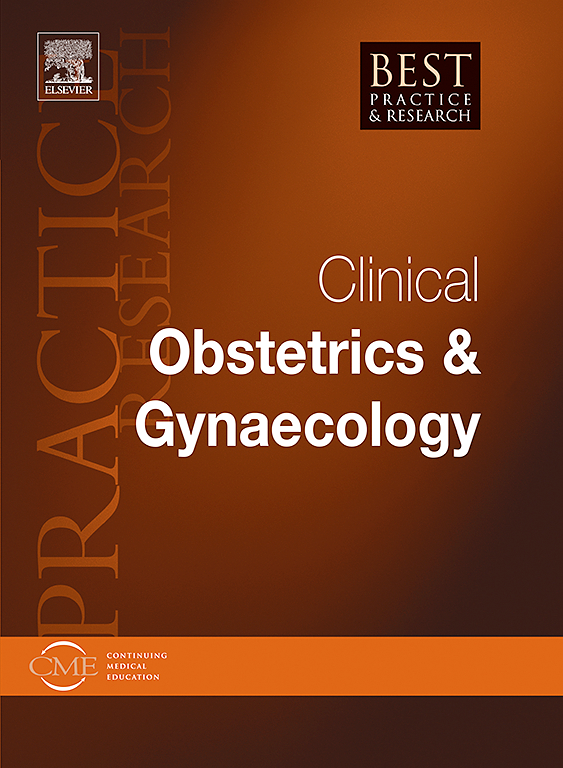Engineering strategies and challenges in building the follicular microenvironment for a bioprosthetic ovary
IF 4.1
2区 医学
Q1 OBSTETRICS & GYNECOLOGY
Best Practice & Research Clinical Obstetrics & Gynaecology
Pub Date : 2025-07-17
DOI:10.1016/j.bpobgyn.2025.102641
引用次数: 0
Abstract
Many individuals with ovaries that utilize fertility preservation because of their progressive disease or gonadotoxic treatment must use ovarian tissue cryopreservation (OTC). Currently, the only option for fertility and hormone restoration after OTC is ovarian tissue transplantation (OTT), or autologous grafting of ovarian tissue. Individuals with disease in their ovaries do not have options to produce a biological child or restore their full ovarian hormone milieu. The goal of developing a bioprosthetic ovary would support full fertility and hormone restoration long-term as a safer and ideally more efficient option than current OTT techniques. In order to develop a bioprosthetic ovary, the field must understand how to control the rate of primordial follicle activation and support the follicle growth through development and maturation into a good quality egg. The follicular microenvironment changes across the lifespan and the growing oocyte is surrounded by a different microenvironment as it is localized in different compartments within the ovary over folliculogenesis. The human ovarian interstitial cells, scaffold proteins and the juxtracrine, paracrine and endocrine signals that influence folliculogenesis are just being realized with the increased data generated by mapping technologies. Recent research has utilized bioengineering tools to interrogate these follicular microenvironment components and better understand the components that are necessary and sufficient to sustain folliculogenesis and produce good quality eggs. However, there are several biological, scalability and regulatory hurdles to overcome in order to realize a bioprosthetic ovary, including the ability to isolate sufficient primordial follicles from their dense stroma while maintaining their quiescence and subsequent transplant longevity. This chapter reviews these components and encourages researchers to continue on these research quests to increase the foundational understanding of human folliculogenesis and develop near-future solutions for infertility on the way to developing the ideal bioprosthetic ovary.
构建生物假卵巢卵泡微环境的工程策略和挑战
由于疾病进展或促性腺毒素治疗,许多卵巢患者必须使用卵巢组织冷冻保存(OTC)。目前,OTC后恢复生育和激素的唯一选择是卵巢组织移植(OTT),即卵巢组织自体移植。患有卵巢疾病的个体无法选择生育一个亲生孩子或恢复其完整的卵巢激素环境。开发生物假卵巢的目标是支持完全的生育能力和激素的长期恢复,作为一种比目前的OTT技术更安全、更理想、更有效的选择。为了开发一个生物假卵巢,该领域必须了解如何控制原始卵泡的激活率,并通过发育和成熟来支持卵泡的生长,成为一个优质的卵子。卵泡微环境在整个生命周期中发生变化,生长中的卵母细胞被不同的微环境包围,因为它在卵泡发生过程中定位于卵巢内的不同腔室。人类卵巢间质细胞、支架蛋白以及影响卵泡发生的近分泌、旁分泌和内分泌信号,正随着制图技术所产生的数据的增加而得以实现。最近的研究利用生物工程工具来询问这些卵泡微环境成分,并更好地了解维持卵泡发生和产生优质卵子所必需和充分的成分。然而,为了实现生物假卵巢,还需要克服一些生物学、可扩展性和监管方面的障碍,包括从致密基质中分离足够的原始卵泡,同时保持其静止和随后的移植寿命的能力。本章回顾了这些组成部分,并鼓励研究人员继续进行这些研究,以增加对人类卵泡发生的基础了解,并在开发理想的生物假卵巢的道路上开发近期不孕不育的解决方案。
本文章由计算机程序翻译,如有差异,请以英文原文为准。
求助全文
约1分钟内获得全文
求助全文
来源期刊
CiteScore
9.40
自引率
1.80%
发文量
113
审稿时长
54 days
期刊介绍:
In practical paperback format, each 200 page topic-based issue of Best Practice & Research Clinical Obstetrics & Gynaecology will provide a comprehensive review of current clinical practice and thinking within the specialties of obstetrics and gynaecology.
All chapters take the form of practical, evidence-based reviews that seek to address key clinical issues of diagnosis, treatment and patient management.
Each issue follows a problem-orientated approach that focuses on the key questions to be addressed, clearly defining what is known and not known. Management will be described in practical terms so that it can be applied to the individual patient.

 求助内容:
求助内容: 应助结果提醒方式:
应助结果提醒方式:


